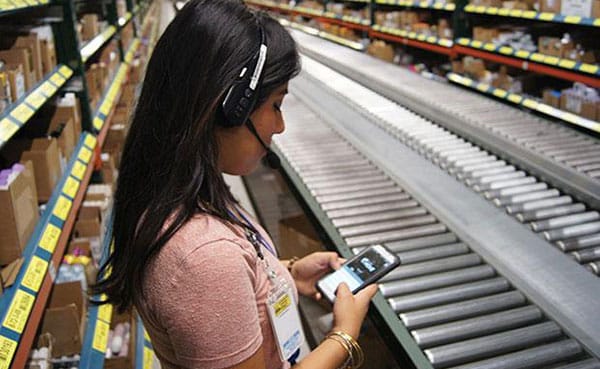By Kyle Franklin, Senior Solutions Consultant, Lucas Systems
Being a veteran of the warehouse industry throughout my career has given me a unique insight into many aspects of distribution interaction. It becomes most apparent when being personally on the customer side. Three recent online buying experiences highlighted different ways inaccuracies could occur in the warehouse. In each case, I was sure what had caused the mistake. And I had some specific thoughts on how they could fix the problem. Please follow along with me as I share the stories and solutions in part 1 of this two part blog series.
What’s the Actual Cost of a Mispick?
 The first instance involved a seller on eBay—presumably a smaller seller, not a massive warehouse operation. I was trying to buy parts for my drone, specifically batteries. Somehow, rather than sending me the single battery I ordered, they sent me a charger, which I had already ordered from another website. Knowing warehousing and distribution, this is probably just a simple mispick, a smaller retailer with limited SKUs that are perhaps using paper picking or even just picking off the computer monitor, picking and packing things directly from a few shelves. So a simple mispick. When you have manual processes, you have these issues.
The first instance involved a seller on eBay—presumably a smaller seller, not a massive warehouse operation. I was trying to buy parts for my drone, specifically batteries. Somehow, rather than sending me the single battery I ordered, they sent me a charger, which I had already ordered from another website. Knowing warehousing and distribution, this is probably just a simple mispick, a smaller retailer with limited SKUs that are perhaps using paper picking or even just picking off the computer monitor, picking and packing things directly from a few shelves. So a simple mispick. When you have manual processes, you have these issues.
They could mitigate these issues by having some order checking in place, whether manual or automated. Barcode scanning or voice-picking solutions are two simple solutions that come to mind. Automating inventory and replenishment can also help avoid stockouts and missed sales opportunities. What do I mean by missed sales? In this case, no voice-picking only had to deal with the return and the extra seller shipping costs, but there was a third consequence. When I tried to reorder that same battery, the system wouldn’t let me order from their site, presumably because I’d previously ordered their last single battery.
So, the total cost was not only all the return fees, but I had to buy that same battery from somebody else because they no longer had it available. That out-of-stock cost is hard to calculate because you often need to know what sales you didn’t make. Whether retail or warehousing, that opportunity cost can add up, especially if someone finds and buys from a new vendor. How many future parts might I have purchased from this vendor?
Mixed-SKUs in Warehouse Slotting Strategies
In the second instance, I did motorcycle maintenance and ordered several different things from vendors. One was a part I ordered from a website I buy from relatively often because of their availability, customer service, product research, and fast shipping. They carry a lot of SKUs since they carry parts for almost every type of motorcycle, plus all their gear and accessories.
When I received the part, it looked correct – labeled correctly with the right brand and motorcycle model – so I was reasonably confident I had the correct item. When I removed it from the package and
started trying to install it, things didn’t seem quite right. I lost an entire morning trying to install the part, to no avail. But when I looked closer at the label, I realized it was the wrong part. It was the correct vendor, but the next size up. I surmised that they most likely utilize mixed SKU slotting, meaning they have several different SKUs in one bin and probably just grabbed the wrong one since they looked identical.
Improve Inventory Management with a Voice Picking System
How do you minimize mistakes like this? As best practices go, we want to reduce mixed SKU slots as much as possible. It makes it tough on the picking process and slows productivity because they have to dig through a bin instead of just reaching and grabbing the right part. Mixed SKU slots cause further slowdowns throughout the day as everyone double-checks to make sure they grabbed the right thing?’ If your warehouse or distribution center is not big enough to support having a single slot for every SKU, add extra validation steps to minimize random errors and protect your bottom line.
For instance, with our voice-directed solution, Jennifer, once you confirm you are in the right location, if we know we are picking from a mixed SKU slot, we do a secondary validation by telling the user either the description or even better and faster, giving them the last three digits of that product code or UPC and then having the user voice back the last four digits, almost as a password for that correct product. In my instance, the items were nearly identical in the description, except one had a 525 and the other had a 520. A simple voice validation check would have easily caught that.
In part 2 of this blog, we’ll look at challenges brought on by mislabeling, human error and the real costs of order picking inaccuracy.
 Kyle Franklin is a Solution Consultant with Lucas Systems, leading numerous solution designs and implementations in the U.S., EMEA and Asia Pacific Regions and helping to transform and optimize distribution center operations worldwide. Prior to Lucas, Kyle held roles in international logistics and warehousing for global logistics providers. Kyle has an MBA with a focus in Operations and Strategy from the Katz Graduate School of Business at the University of Pittsburgh and a B.S. in Economics from the University of Illinois at Chicago.
Kyle Franklin is a Solution Consultant with Lucas Systems, leading numerous solution designs and implementations in the U.S., EMEA and Asia Pacific Regions and helping to transform and optimize distribution center operations worldwide. Prior to Lucas, Kyle held roles in international logistics and warehousing for global logistics providers. Kyle has an MBA with a focus in Operations and Strategy from the Katz Graduate School of Business at the University of Pittsburgh and a B.S. in Economics from the University of Illinois at Chicago.
About Lucas Systems
Our solutions are built on 25+ years of deep process expertise and intelligent software using AI and voice technologies. Our solutions feature Jennifer™, the brain, voice, and orchestration engine that drives performance improvement gains. Make the smartest moves at the lowest cost with Jennifer™. For more information, contact us today!





